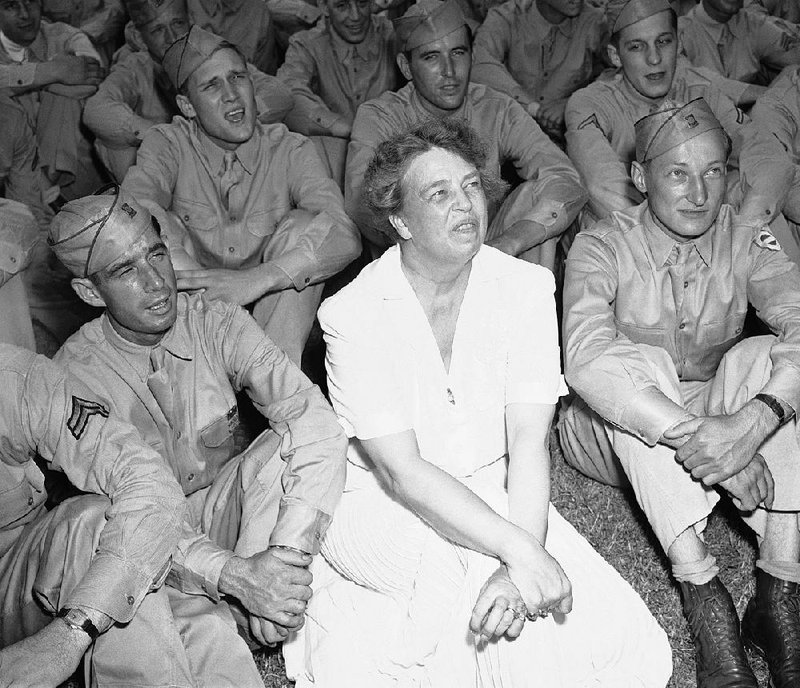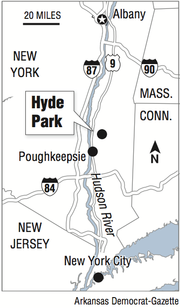HYDE PARK, New York -- Home, for Eleanor Roosevelt, was Val-Kill in Hyde Park, N.Y.
Near Springwood, the family estate overlooks the Hudson, where her husband, Franklin Delano Roosevelt, was born. Val-Kill, on Roosevelt property, is her own place. Away from Franklin, and the other Mrs. Roosevelt -- his mother, Sara. But also away from ... everything. Up a windy road off U.S. 9, mountainward instead of toward the river and its millionaire-worthy views.
I'd been to the Eleanor Roosevelt National Historic Site, the 180-or-so acres Eleanor called Val-Kill, about 20 years ago. I'd toured her home there, Val-Kill Cottage, a place that, when you stepped in, closed itself around you like a hug. A place with fitted slipcovers. A stone fireplace. A big furniture-radio. Christmas cards, framed, on the dining room walls. Wood paneling, hung with faded black and white photos. Eleanor with one of her sons. Her friends. Eleanor with Nikita Khrushchev. John F. Kennedy. Winston Churchill.
I knew Eleanor had a busy life. I thought that was all I needed to know.
I hadn't thought of going back, then, until I heard that another small building on Eleanor's bit of turf, Stone Cottage, was opening to the public.
Stone Cottage was actually the original building on the property. A place two of her best friends used as a residence. The building has been restored today not as a house museum, however. Instead, it is dedicated to Eleanor's early political life, and the rise of women in politics: "Eleanor Roosevelt and Val-Kill: Emergence of a Political Leader."
I realized that it really is good to go back, sometimes. Been there, done that can really be a deleterious concept when it comes to travel and, well, a lot of things come to think of it.
I didn't know all she did on her hill. And much of what she did, and thought, bears repeating, and remembering.
"This wasn't a retreat," said Frank Futral, curator of the Roosevelt-Vanderbilt National Historic Sites and designer of the permanent exhibition at Stone Cottage, which took three years to put together. "This was a place where she thought, and did."
It was a think-and-do tank, actually. And the ranger said he had not even known just how much Eleanor did there.
Eleanor was no hermit. She loved having people over, playing hostess and grandma and mother hen and -- to her own surprise -- diplomat.
Lonely Childhood
Eleanor, though born into a life of privilege in 1884, was an orphan by the time she was 10 -- her mother died when she was 8, and her father died less than two years later, of alcoholism. She was raised by grandparents in the Hudson Valley town of Tivoli, until she was shipped off to boarding school in London.
She married FDR -- a fifth cousin -- in 1905 and set about the duties of a wifely life, which she had already decided meant supporting her husband's endeavors. Little did she know how much of a role she would be called on to play when Franklin was struck with a near-fatal case of polio in 1921.
Not only did she have to help him adjust to a whole new way of life, but was urged, by Franklin's advisers, to keep his political ambitions alive by taking up causes and public speaking.
Though loath to do so at first (she writes in her memoirs that she was painfully shy), she soon realized she was pretty good as a speaker and a motivator, and there was a lot she wanted to speak passionately about. By the time her husband was elected president (the first of four times) in 1932, she was redefining the role of the first lady entirely.
But we're getting ahead of ourselves.
Let's get back to Hyde Park. Val-Kill. The Stone Cottage.
The Roosevelts' Springwood home was always a summer retreat for the family -- Sara Roosevelt held forth there. Eleanor and Franklin were married there and spent time there and brought their family and friends around.
One day in 1924, Eleanor and two close friends, Nancy Cook and Marion Dickerman, were at a picnic with FDR and two of their sons at nearby Fall Creek -- a quiet spot on the Roosevelt's property about two miles east of Springwood. At the time, Eleanor lamented about having to leave Hyde Park when Springwood closed up for the season. Franklin suggested they build a "shack in the woods" for themselves right there.
The women thought it was a great idea and planning began immediately for a place of their own on Fall Creek -- Val-Kill, in Dutch.
The cottage was built by the end of 1925.
Even before it was finished, though, the women had another idea for the property. FDR had been voicing concerns about the migration of people from rural areas to the cities to find employment.
In a few areas, "cottage industries" had been helpful in stemming the flow of youth away from farms. The women decided to create Val-Kill Industries, setting up a small shop to turn out furniture and crafts in the early American style. All agreed.
The business partners built not only the stone cottage but a factory on the grounds.
The idea was an almost immediate success. The cottage industry at Val-Kill hired its first permanent craftsman in 1926. By 1934, the enterprise expanded to a pewter forge and weaving shop. Two years later, however, the shops were closed because of the Great Depression.
At the time, Eleanor had a new mission: She became the president's legs, literally, traveling across the country to gather firsthand knowledge of the state of a United States in the throes of economic disaster. She returned to report on intolerable conditions and urged swift actions -- her contribution to the Roosevelt administration, and that era, was in retrospect deemed immeasurable.
After FDR's death less than three months after his fourth inauguration in April 1945 and the gift of Springwood to the government for use as a historic site, Eleanor moved to Val-Kill for her permanent home. Franklin was buried in Hyde Park, and it was where heads of state came to pay their respects. A reporter covering one of those visits asked Mrs. Roosevelt what was next, to which she responded, "The story is over."
New role in the world
The story, though, wasn't over. Eleanor Roosevelt went on to her greatest accomplishments -- including her roles as the first female representative of the United Nations and the force behind the Human Rights Declaration -- when her own story, without FDR, began.
She had once described Val-Kill as the place "where I used to find myself and grow" and where "I emerged as an individual." She gained strength and inspiration from the pastoral surroundings. Her story there continued for two decades.
Amazing, then, that the place was almost sold to a developer for condos. Eleanor died on Nov. 7, 1962, and her son John took over and soon converted her home into four apartments that he rented out. In 1970, he actually sold Val-Kill to developers who planned to create a retirement community/nursing home on the site.
In 1976, a local group, with some state and local figures as well as Roosevelt family members, was formed to save Val-Kill from development. In 1977, President Jimmy Carter signed a proclamation creating the Eleanor Roosevelt National Historic Site, and it remains the only National Historic Site dedicated to a first lady. The organization that saved the property, the Eleanor Roosevelt Center at Val-Kill, offers programs including a leadership project for young women from diverse backgrounds.
And Stone Cottage is still being used to promote Eleanor's vision. It's a small, small space to put a lifetime's worth of memories, accomplishments and inspiration. It can get even smaller feeling on particularly crowded days. The exhibition includes a variety of methods for conveying information in compact, space-saving ways -- videos among them.
A video is the first thing you may see when going through the small door into the building. A video that very likely will cause a knot in the visitor flow because it's so fascinating.
It's a loop of what are in effect home movies taken by her friend Nancy Cook of Eleanor and folks who came to visit -- everyone from King George VI and his wife, Elizabeth, and ready-for-her-close-up, crinoline-flapping Shirley Temple to Queen Wilhelmina of the Netherlands and even Mr. President himself. It's utterly charming, this video, giving visitors a taste of the hospitality the Roosevelts -- Eleanor in particular -- were known for.
In the main exhibition room is another technique for layering information: Below some displays on the walls and cases, you'll find drawers with artifacts that further illustrate a point. For instance, on the topic of Eleanor's efforts to empower other women, you can open a drawer to find a copy of the Women's Democratic News she helped found and publish.
Remember to look for these hidden-away pieces; if I hadn't seen a drawer already opened, I might not have noticed them.
You'll also see a timeline on the wall, following Eleanor's progress and important moments in the context of world events. Here, too, read carefully. Among the significant events highlighted from 1917 to 1919, for instance, are "U.S enters World War I," and "Eleanor volunteers during World War I with Red Cross canteens, Navy League knitting projects and naval hospitals" and "New York gives women the right to vote" as well as "Eleanor discovers love letters between FDR and Lucy Mercer."
Another nice sleight of space-saving: Officials are still in the process of finding original furnishings that were sold in the 1970s, but in the middle of the room is a scrim that drops down to dovetail seamlessly with an original couch from the main room, the scrim depicting the furnishing from an old photograph.
There was a lot to read about, and I'll admit I was most often charmed by some of the backstage photos -- like FDR wearing a toga in response to critics who likened him to a Roman emperor.
But upstaging even the video of Franklin doing a sort of thumb-wrestle for the camera was just what a force Eleanor was in shaping modern history.
In 1946, President Harry S. Truman, who'd given Eleanor the nickname First Lady of the World, recruited her to be one of the members of the first American delegation to the United Nations -- and the first female delegate at the U.N.
In London, where the first meeting was held, and then back in Val-Kill, Eleanor played the key role in the drafting and adoption of the Universal Declaration of Human Rights. Her commitment to justice often placed her at risk and made her an easy target -- sometimes literally -- for critics. (In the "Close to Home" introductory video you learn that the Ku Klux Klan had put a price on her head. Despite that, and her advisers' fears, she took a trip into the Deep South, without incident.)
In 1961, President John F. Kennedy appointed her chairman of the first Presidential Commission on the Status of Women.
She died the next year.
Stone Cottage brings a little bit of Eleanor back to life. In this quiet enclave, where she and her friends made history, her spirit is home.
For more infoirmation, visit nps.gov/elro or (845) 229-9422.
Travel on 09/14/2014

